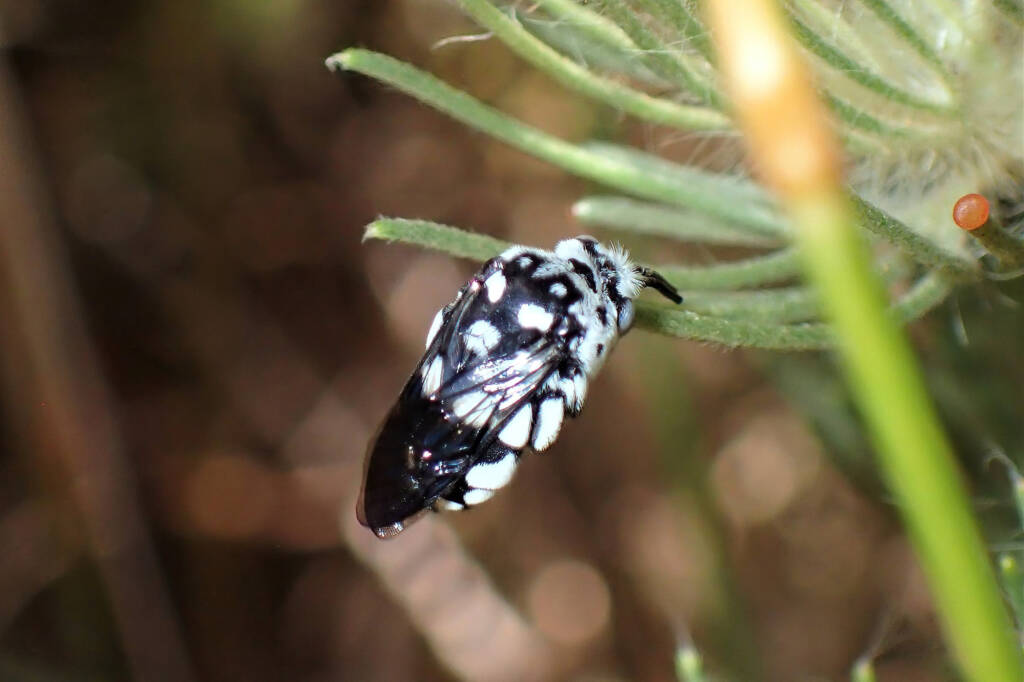The Woolly Bush (also spelt Woollybush and woolly-bush, in reference to the hairy foliage) is a common name given to plants in the genus Adenanthos. Another common name is Jugflowers, Jug Flowers and Stick-in-jug, that makes reference to the shape of the flower.1
Adenanthos flowers are solitary, rather than clustered together in large showy inflorescences. In fact, morphologically speaking, the Adenanthos flower does occur in an inflorescence, but one in which the number of flowers has been reduced to one, leaving only a few vestigial clues to the elaborate structure from which it derived. Each flower is positioned at the end of a short peduncle.
Source: Wikipedia2

The genus is endemic to Australia…
of which out of the 34 species (identified at the time of writing), plus two hybrid (see iNaturalist reference3), 31 of the species are confined to the southwestern corner of Western Australia. Adenanthos terminalis extends into South Australia and western Victoria and Adenanthos macropodianus is endemic to Kangaroo Island. Adenanthos species range from small shrubs to small trees.
Source: Australian Plants Online (adapted from)4

The plants of this genus are hermaphrodite, although entomophilous (insect pollination), ornithophilous (bird pollination), and being pollinated by small marsupials also occur.
Adenanthos comes from the Greek ‘aden‘ meaning “a gland” and ‘anthos‘ meaning “a flower”. This is in reference to the flowers’ prominent nectaries. The specific epithet is the Latin word meaning “silky” in reference to this plants very soft foliage.
The Woolly Bush pictured here is Adenanthos cygnorum, and not Adenanthos sericeus (also known as Coast Woollybush is native to King George Sound on the southern coast of Western Australia). Whilst both species are very similar Adenanthos cygnorum has the very prominent extra floral nectaries. The plant provides a great source of nectar for small honeyeaters and insects such as our Australian native bees.
Pictured here with the Woolly Bush is the Thyreus waroonensis, the photo being taken in the Midwest of Western Australia.
In the photos, you can see just to the top right of the Waroona cuckoo bee (Thyreus waroonensis) the nectaries on the woolly bush, the modified leaves that have little sugar secreting and brightly coloured pads on the end.

This page is a work in progress.
We certainly welcome photographs of this bush and any images used will include your name as copyright holder. You can contact us for our email address or contact or share to us through Facebook.
- Scientific classification
- Kingdom: Plantae
- Phylum: Charophyta
- Class: Equisetopsida
- Subclass: Magnoliidae
- Superorder: Proteanae
- Order: Proteales
- Family: Proteaceae
- Genus: Adenanthos
- Species:
- Adenanthos acanthophyllus
- Adenanthos apiculatus
- Adenanthos argyreus
- Adenanthos barbiger
- Adenanthos cacomorphus
- Adenanthos cuneatus
- Adenanthos cygnorum
- Adenanthos detmoldii
- Adenanthos dobagii
- Adenanthos dobsonii
- Adenanthos drummondii
- Adenanthos ellipticus
- Adenanthos eyrei
- Adenanthos filifolius
- Adenanthos flavidiflorus
- Adenanthos forrestii
- Adenanthos glabrescens
- Adenanthos gracilipes
- Adenanthos ileticos
- Adenanthos intermedius
- Adenanthos intricatus
- Adenanthos labillardierei
- Adenanthos linearis
- Adenanthos macropodianus
- Adenanthos meisneri
- Adenanthos obovatus
- Adenanthos oreophilus
- Adenanthos pungens
- Adenanthos sericeus
- Adenanthos strictus
- Adenanthos teges
- Adenanthos terminalis
- Adenanthos velutinus
- Adenanthos venosus
- Adenanthos × cunninghamii
- Adenanthos × pamelus
Footnote & References
- Adenanthos Labill, Western Australian Herbarium (1998–). Florabase—the Western Australian Flora. Department of Biodiversity, Conservation and Attractions. https://florabase.dbca.wa.gov.au/ (Accessed 30 September, 2023). https://florabase.dbca.wa.gov.au/browse/profile/22379
- Adenanthos, Wikipedia, https://en.wikipedia.org/wiki/Adenanthos
- Jugflowers Genus Adenanthos, iNaturalistAU, https://inaturalist.ala.org.au/taxa/145448-Adenanthos
- Adenanthos……. a member of the Protea family, Australian Plants Online, https://anpsa.org.au/APOL19/sep00-5.html
- Photographs Woolly Bush © Gary Taylor
- Under the Woolly Bush, blog series by Gary Taylor
- Many thanks to members of The Wildflower Society of Western Australia (Inc.), Facebook group for their input and contribution, including Kath Gray (for pointing out the difference between A. cygnorum and A. sericeus, and to Alex Chapman (for highlighting the word is ‘nectaries’ and not ‘nectarines’), https://www.facebook.com/groups/129636970391772/
FloraFlora in Australia Flora Index Acacia Anigozanthos (Kangaroo Paws) Annual Yellowtop Apium prostratum subsp. prostratum var filiforme Apple Bush (Pterocaulon sphacelatum) Australian Bluebell Australian Gossypium Banksia Batswing Coral Tree Billy Buttons Birdsville Indigo Blue Pincushion Bush Banana Callistemon Callitris drummondii (Drummond’s Cypress Pine) Calothamnus quadrifidus Cape Honeysuckle Cassia fistula (Golden Shower) Cattle Bush Common Heath Crotalaria Darwinia wittwerorum (Wittwer’s Mountain Bell) Daviesia oppositifolia (Rattle-pea) Desert Oaks Drumsticks Eremophila Eucalyptus Ficus Flannel Cudweed (Actinobole uliginosum) Georges Indigo Goatshead Burr (Sclerolaena bicornis) Golden Everlasting Goodenia Gossypium Grass and Grasses Grass Trees Grevillea Grey Germander Hakea Kapok Bush (Aerva javanica) Lambertia sp Leptospermum MacDonnell Ranges Cycad Maireana scleroptera Mexican Poppy Minnie Daisy Mistletoe Family Nardoo Native Apricot Nicotiana megalosiphon subspecies sessilifolia Nuytsia floribunda Orange Spade Flower Orchidaceae Parakeelyas (Calandrinia) Pebble Bush (Stylobasium spathulatum) Perennial Yellow Top Pink Everlasting Pink Rock Wort Poached Egg Daisy Portulaca Proteaceae Ptilotus Quandong Resurrection Fern Rosy Dock Ruby Saltbush Santalum Solanum Spike Centaury Spinifex Storkbill (Erodum cygnorum) Striped Mint Bush Sturt’s Desert Pea Sturt’s Desert Rose Tall Saltbush Tangled Leschenaultia Tar Vine Tribulus eichlerianus Upside-down Plant Urodon dasyphylla Variable Daisy Waratah (Telopea) Wertabona Daisy White Cedar (Melia azedarach) White Indigo White Paper Daisy Wild Passionfruit Wild Stock Woolly-Headed Burr Daisy Woolly Bush Yellow-keeled Swainsona
Flora & FaunaFauna Flora Fauna Flora Funga Glossary Funga Related Topics Scientific Classification Backyard Wildlife Floral Emblems of Australia Wildflowers
